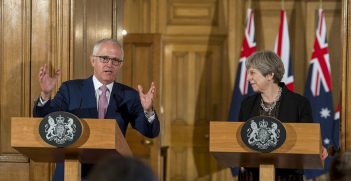Bilateral Free Trade Negotiations: A Novel and Challenging Enterprise for the UK

As the UK celebrates achieving Brexit by leaping into highly political FTA negotiations with the EU, US, and Australia (among others), its trade negotiators will hopefully have learned some strategic lessons from Australia’s experience negotiating its FTA with the US.
The recent leaking of hundreds of pages recording the scope of the UK-US Free Trade Agreement (FTA) preparatory discussions surprised many. These papers prompted multiple commentators to provide analysis and competing interpretations of consequences for the UK’s NHS. However, in the highly charged pre-election environment, they generally failed to impress on the UK public or the broader media the highly complex task ahead.
This US Summary of Specific Negotiation Objectives is the formal framework document for the UK-US FTA. It is highly relevant, providing the mandate and deliverables endorsed by the powerful US Trade Advisory Committee.. While the final text is yet to be negotiated, the FTA models and trade objectives are known. The unknown factor is political – how selectively or comprehensively national interest will be defined, protected or sacrificed.
Trade Agreements: No “Likeminded Friends” in Bilateral Negotiations
Australia’s experience negotiating an FTA with the US should be of interest to the UK, given Australia and the UK both have national health systems and clever drug procurement and governance rules enabling access to affordable and effective pharmaceuticals. This is also especially of interest given the Australia/US Free Trade Agreement (AUSFTA) substantially impacted on Australia’s health system, with some consequences taking years to be exposed.
Overall, the US objectives for the UK closely harmonise with Australia’s AUSFTA (effectively, the US prototype with Australia was included and enhanced in all subsequent FTAs). Consequently, Australia’s negotiating experience should be of strategic interest to the UK to understand the scope and complexity of such legally binding obligations.
The AUSFTA legal obligations are peppered throughout 23 chapters, three annexes and 26 side letters on sensitive issues such as Australia’s drug pricing policies, voluntary blood bank, and ISP liability.
Fifteen years after its entry into force, the AUSFTA remains complex and rarely understood, as was revealed by this retrospective research on its consequences. Obligations particularly involving intellectual property, pharmaceuticals, and digital economy among other issues are replicated (and built upon) in the Trans Pacific Partnership (TPP).
When President Trump refused to ratify the TPP, the other eleven states established the alternative TPP-11 Comprehensive Partnership but suspended 20 highly controversial obligations, some capable of imposing significant ongoing costs into health systems. If the US re-joins the TPP, these 20 obligations are likely to be reinstated, including biologics/biosimilars data exclusivity issues already raised in the leaked US/UK discussions. The UK has indicated interest in joining the TPP/TPP-11.
UK Public Health, Consumers, and NGO Interests – The AUSFTA Translated
Regarding sovereign decision-making demanded by Brexit voters, it should be noted when regulatory changes are being considered the AUSFTA enables access to officials and industry representatives of the “other party” to the Free Trade Agreement to enter into the policy and regulatory decision-making processes, with obvious consequences on national interest decision-making. These “behind the border measures” would not accord with Brexiteers’ demands for their so-called “taking back of control.”
In Australia, political guarantees given to exclude Australia’s Pharmaceutical Benefits Scheme from the AUSFTA were creatively broken. Citing the need for “transparency, meaningful consultations, and accountability,” this side letter enables US pharmaceutical industries the right to engage in decision-making processes within Australia’s Pharmaceutical Benefits Scheme. This extensive access includes to the PBS Advisory Committee responsible for the access and pricing decisions based on efficacy/comparative value of the drug being considered. Access for the US pharmaceutical company occurs both during the negotiation/ application process – providing opportunities to consult relevant PBS officials – and should the outcome not be acceptable – information is provided on the decision and the company can seek an independent review.
These complex policy alterations to the PBS and other related health transformations also continue to grow through the many mandatory bilateral working groups that reach right into Australia’s policy processes. Some obligations flowing from the AUSFTA have taken years to take effect, and just as long to understand the consequences. This includes the increasing costs of Australia’s health system.
The “chlorinated chicken” food safety issue in the UK generates heated debate and is one of the few concerns shared among “leave” and “remain” supporters. The AUSFTA obligation enabling the “other parties” officials and industry representatives to participate in policy decisions related to food safety mechanisms can limit national decision-making, including on labelling, food, testing, drug and chemical/pesticide licensing regimes etc. These FTA obligations, referred to as “behind the border” measures, apply to both countries but realistically, the political clout lies with the dominant party.
These sovereign limiting “behind the border” agreements go further than the WTO obligations by enabling the “other parties” (officials and industry representatives) to participate in decision-making prior to altering regulations/guidelines. For bureaucracies and politicians, the prospects of such intrusions into national policy decision-making can block or inhibit proactively addressing consumer interests, national health interests, and biosecurity measures. This includes issues such as antimicrobial resistance in the food chain.
Post-AUSFTA Implementation: Assessments from Advisory and Government Bodies
The following assessments should be of interest in understanding the consequences or unintended effects of the AUSFTA:
- Australia’s Productivity Commission Report on the impact of Bilateral and Regional FTAs, including the AUSFTA, focused on trade and investment barriers and Australia’s economic performance.
- The Review of Pharmaceutical Patents addressed the intellectual property provisions revealing problems limiting Australia’s generic manufacturing base, employment, exports, and increasing pharmaceutical costs.
- Updated assessments of the actual trade outcomes of the AUSFTA have also revealed disappointing results.
It is easy to disregard criticism of FTAs as simply underpinned by anti-globalisation or NGO criticism, but these formal national interest evaluation reports reveal some significant adverse outcomes from Australia’s FTAs. Trade negotiations involve judgements of national interest, and FTA language is complex and embedded with legally binding obligations. For the UK, heeding the lessons learned from others can be valuable.
Anna George is a former Australian ambassador, adjunct professor at the Sir Walter Murdoch School of Public Policy and International Affairs at Murdoch University, and associate fellow at the Centre on Global Health Security, Chatham House.
This article is published under a Creative Commons Licence and may be republished with attribution.





